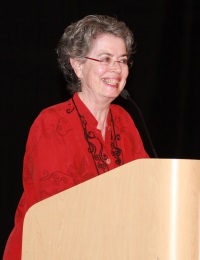June 2
Building Bridges: Health Literacy Support for Multi-Cultural Communities
0 comments
June 2
0 comments

Victoria Purcell-Gates started off her presentation by discussing the relationship between literacy and culture. “Culture is what holds a group of people together,” and it may include beliefs, language, and more. She showed many examples of literacy in practice. If you study these, you can learn a lot about their culture, she said.
Health literacy is an instance of socially situated literacy, she said. It includes reading, writing, speaking, and listening within the social activity of health. Health literacy is the domain of social activity centered around the maintenance of health, physical fitness, and bodily care. It includes reading prescription or shampoo bottles, filling in a medical form, reading health-related magazines, reading bathroom signs, and keeping a dietary journal, she said.
Health Literacy is embedded in social networks. People learn skills faster if they are taught in the context of real-life literacy activity and they are explicitly taught, she said. “Thinking about health literacy this way is going to deepen our understanding. We talk to a lot of other people about our health — not just our doctor,” she said.
Real-life literacy instruction is when teachers engage their students in reading and writing real-life texts for real-life reasons. Classroom examples include:
In order to build bridges with multicultural students, Purcell-Gates urged practitioners and health literacy teachers to learn the health literacy practices in the lives of their students. “You need to get to know your students — their visions and models of health. Then build activities that build on those,” she said. “Spend time in the community — go to community meetings, wash your clothes in the Laundromat, shop in the stores. It takes time to get past your own preconceptions on what you expect to see. It’s like when you travel in another country: You can’t get everything you need from a guidebook. You need to spend time there.”
Tags